Henk de Swardt is the chief engineer responsible for technical support to Timken Power Systems’ electric motor division. This division includes Smith Services, Schulz Electric, and H&N Electric facilities, which have complete electric motor and generator repair services and other specialty capabilities. Henk obtained a Bachelor of Science in Electric and Electronic Engineering from the University of Johannesburg, South Africa, in 1995. He is an electric motor design engineer by trade with more than 26 years of electric motor experience at various OEMs and repair companies in the U.S. and internationally. In a recent Plant Services webinar, “How to Use Testing to Ensure the Reliability of Aged Synchronous Motors and Generators of 4000 to 35000 hp,” Henk spoke with editor in chief Thomas Wilk about best practices for testing large synchronous motors and generators. Below is an excerpt from the Q&A portion of the webinar.
PS: You mentioned surge testing. Can’t I use an impedance tester instead of a surge tester?
HDS: Oh, no. We get that question frequently. Impedance testing attempts to do what the surge tester does, but it tests at like 5 volts. Now if you've got a 13,800 volts stator winding, then testing at such a low voltage (unless there is a dead short somewhere in the winding) you will not see anything. These are large machines. You need to test them at an elevated voltage, even exceeding the supply voltage, so that you can find even weaknesses in the installation before it has failed. So definitely not an impedance tester; a surge tester, yes.
PS: This question is about one of the more advanced test methods you cover toward the end of the presentation. This one's on the LEAP test: the LEAP test that predicts the remaining life of the stator insulation sounds amazing. Can this test also be used on the rotor insulation?
HDS: Unfortunately, it cannot. The test is designed specifically for 4,000 volt and larger machines. And obviously, on a stator, you wouldn’t have 4,000 volts. Because it uses partial discharge measurements as part of the assessment condition, and on low voltage that's on the rotor, there is no partial discharge so the test would be completely ineffective. Sorry, can't help you there.
PS: The newest wind generators that are installed tend to fall into the lower range of your presentation. They are four megawatts and larger. Do your tests also apply to these generator motors?
HDS: That's a great question. Yes, the tests do apply. Like I said, the LEAP test, you need to be 4 kV winding. The old Sol generators did not go that high voltage. But these days, we've seen 3 MW machines 10 kV, 3.5 MW, 6.5 MW, that is 10,000-11,000 volts, so yes, the LEAP test would apply. You will not practically be able to test the machine while it's in the cell. Definitely not. But all of the other test instruments are portable. These days, the latest generation of surge tester is the size of a small briefcase, and you can absolutely take it up in the tower. You can do a surge test, insulation resistance test, polarization index, and resistance test all with one instrument. Absolutely, definitely, you can do that.
PS: What should be the acceptance limit of IR tests according to different voltages?
HDS: All of these tests are governed by IEEE standards – apart from the LEAP test, which is a proprietary test – but the insulation resistance test is governed by IEEE Sstandard 43. If you read the standard, it shows very much how it works and everything. They used to have acceptance criteria that were based on voltage. It was bad. It was the voltage divided by 1,000 plus one megohms, so for an 11 kV machine it would be 12 megaohms. And the whole repair industry said, “no, you are crazy.” So after many years of us complaining, they changed the standard that the minimum acceptance insulation resistance is 100 megaohms. And before you start a machine, you need at least 100 megaohms, although on a large generator, 100 megaohms is not great. I mean, it doesn't show that the machine is bad, but it could indicate that there is some contamination on the winding. You will typically see 300, 400, 500, even a gigohm. But the standard says you need to have at least 100 megohms.
